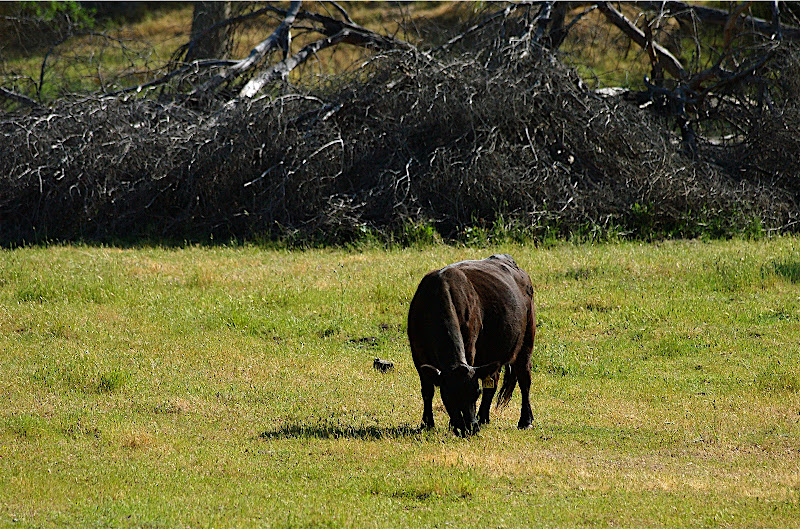File this one under the "who woulda thunk it?", or "why didn't I think of this?" or simply "whaaa...?!" categories! Quick, can you tell which way is north in this picture?

Do you think of asking the cow for directions? Why not? For it seems that cow probably knows which way north is!
You know, these big dumb-seeming large mammals you pass by every day, these big walking, grazing cheese-producing happy cows dotting the picturesque landscapes of California's grassy hillsdes, or their scrawnier but holier cousins clogging up traffic throughout India? Well, there is more to them than meets the eye - in fact this curious tidbit about their natural history seems to have escaped notice from even the keenest cowboy, cattle-herder, animal husband (I'm not sure if that's what one calls someone practicing animal husbandry - is it?), or drunken late night cow-tipper, throughout history.
It took some creative but fairly straightforward analysis by German scientists of satellite imagery now available via Google Earth to discover that cows, while grazing or resting, chewing cud tend to orient their bodies along the magnetic north-south axis!! And its not just cows, deer also appear to do the same! How cool, and odd, and curious is that?! And what a clever application of Google Earth imagery? This team simply measured the orientation of 8510 cows in satellite images of 308 pastures across the globe, and found that over two-thirds of the animals orient themselves along a north-south axis!! Apart from simply asking the question (who woulda thunk?), the analysis was careful enough to account for local variation in magnetic fields, and shows that the animals orient according to the local field, not geographic north!
Which raises all kinds of interesting questions worth following up on, some of which you can read about in the original PNAS paper published in an early online edition this week, and in this Los Angeles Times article covering it. Here's the abstract from PNAS:
Magnetic alignment in grazing and resting cattle and deer
Sabine Begall, Jaroslav Červený, Julia Neef, Oldřich Vojtčch, and Hynek Burda
Abstract
We demonstrate by means of simple, noninvasive methods (analysis of satellite images, field observations, and measuring “deer beds” in snow) that domestic cattle (n = 8,510 in 308 pastures) across the globe, and grazing and resting red and roe deer (n = 2,974 at 241 localities), align their body axes in roughly a north–south direction. Direct observations of roe deer revealed that animals orient their heads northward when grazing or resting. Amazingly, this ubiquitous phenomenon does not seem to have been noticed by herdsmen, ranchers, or hunters. Because wind and light conditions could be excluded as a common denominator determining the body axis orientation, magnetic alignment is the most parsimonious explanation. To test the hypothesis that cattle orient their body axes along the field lines of the Earth's magnetic field, we analyzed the body orientation of cattle from localities with high magnetic declination. Here, magnetic north was a better predictor than geographic north. This study reveals the magnetic alignment in large mammals based on statistically sufficient sample sizes. Our findings open horizons for the study of magnetoreception in general and are of potential significance for applied ethology (husbandry, animal welfare). They challenge neuroscientists and biophysics to explain the proximate mechanisms.
So what's the underlying mechanism cows use to sense the magnetic field? Do they also have magnetic particles in their brains like many better studied migratory species known to orient magnetically? Why do they do this? Domestic cows are not, of course, migratory any more (at least not on their own), so what might they gain by orienting magnetically? Or is this simply a vestige of their evolutionary history, from ancestors who actually put that magnet to use? And do they prefer to point their heads north or their behinds? The satellite photos are not sharp enough to tell apparently, so answering that may require some ground-truthing! Opens up a whole new line of research, doesn't it?
And as for why so many humans who have spent much time with cows failed to notice this uncanny magnetism, here's a priceless quote from the LA Times, from a dairy farmer right here in the Central Valley, no less:
Asked whether he had ever observed such behavior in cows, dairy farmer Rob Fletcher of Tulare, Calif., said, "Absolutely not." But, he added, "I don't spend a lot of time worrying about stuff like that."
I suspect, however, that the last laugh belongs to the cows, as only Gary Larson could have guessed! Remember this from his insightful pen?
That's why it took satellites to notice this particular behavior! What else have the cows been up to then?
Reference:
Begall, S., Cerveny, J., Neef, J., Vojtcch, O., Burda, H. (2008). Magnetic alignment in grazing and resting cattle and deer. Proceedings of the National Academy of Sciences DOI: 10.1073/pnas.0803650105








2 comments:
or they're keeping their eyes out of the sun.
oh but they've found a new breed of cow in australia which faces south!?
That's an interesting hypothesis - perhaps it does have to do with the sun, and they may face in opposite directions in the northern vs. southern hemisphere. Remember, the satellite photos were not of sufficiently high resolution to tell. And you should expect seasonal variation if that is the case. I don't know if they analyzed the photos by date.
What about tropical cows, though? I think the greater effect of the local magnetic field is the key evidence that they are sensing that, rather than orienting by the sun.
Post a Comment